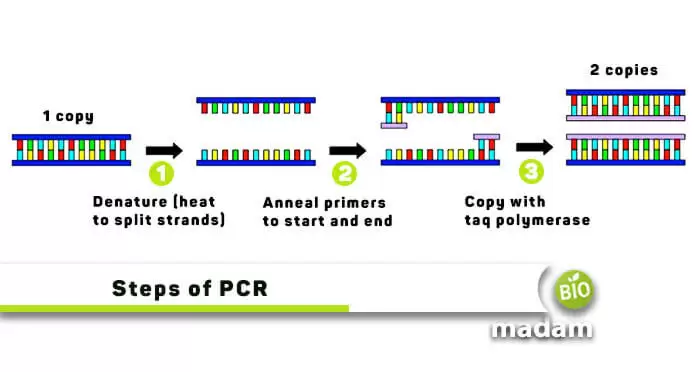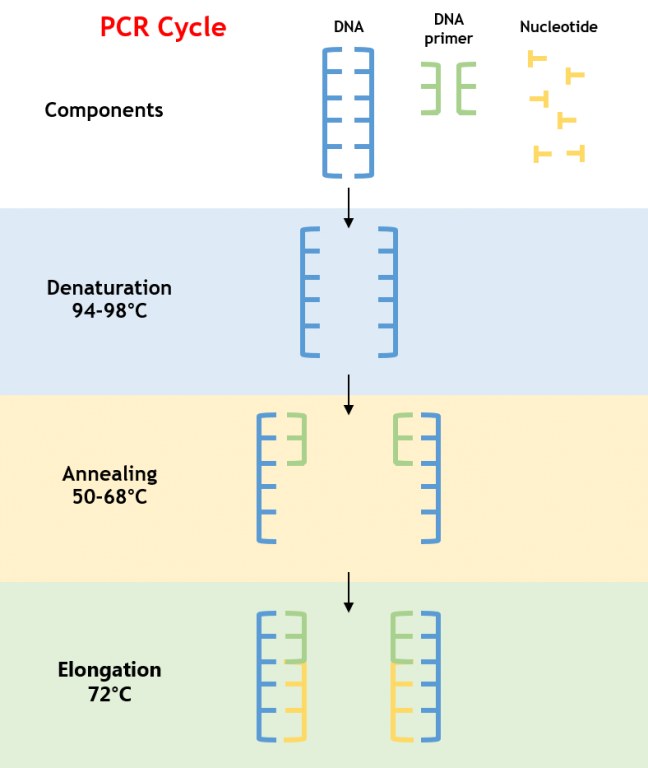The Taq enzyme is a type of DNA polymerase that allows researchers to separate the DNA strands during the annealing step of the PCR cycle without destroying the polymerase. During which step in the PCR cycle are nucleotides used.

Polymerase Chain Reaction Definition Steps Britannica
Collection preparation amplification and post PCR clean-up.

. During the extension or elongation step Taq polymerase binds to each PCR primer and begins adding nucleotides. The PCR machine steps happen in the amplification step. Eeeeee9918 is waiting for your help.
The last step of the Calvin cycle is regeneration in which molecules of glyceraldehyde-3-phosphate as well as ATP are used in order to recreate ribulose biphosphate the original carbon dioxide. The newly added nucleotide forms a bond with the hydroxyl -OH group on the 3 end of the primer. The ingredients are assembled in a tube along with cofactors needed by the enzyme and are put through repeated cycles of heating and cooling that allow DNA to be synthesized.
During which step in the PCR cycle do primers form bonds with a single-stranded template. During which step in the PCR cycle are nucleotides used. Thus more nucleotides are added to the 3 prime end of the DNA polymerase.
PCR stands for polymerase chain reaction which is a laboratory procedure that can be used to create copies of DNA. Nucleotides are used to synthesize the complementary strand to the DNA template during the extension step. The polymerase begins synthesizing new DNA from the end of the primer.
Primers are single strands of nucleic acids synthetic oligonucleotides that are necessary to initiate the PCR. Primers will anneal to the DNA template during the Annealing step indeed which is after the Denaturation step. Therefore a primer is required.
At the beginning of the PCR reaction the temperature is usually set up to 9598C depending on the polymerase used. C The third step in a PCR cycle is called the extension or elongation step. During the cooling annealing phase of PCR the primer binds to the target and initiates copying of the target DNARNA sequence.
In fact during this step the DNA template is heated to about The second step in a PCR cycle is carried at 55-65C and is called In few sentences describe what happens during this step. Nucleotides dNTPs or deoxynucleotide triphosphates - single units of the bases A T G and C which are essentially building blocks for new DNA strands. Complete denaturation of the input DNA helps ensure efficient amplification of the target sequence during the first amplification cycle.
This is where the automation is most appreciated. The initial denaturation step is carried out at the beginning of PCR to separate the double-stranded template DNA into single strands so that the primers can bind to the target region and initiate extension. In PCR a short segment of DNA is amplified using primer mediated enzymes.
These single strands of DNA or RNA are specific and complementary to the target DNARNA sequence portion. Template DNA is the DNA that is amplified during a PCR reaction. The DNA polymerase can add a nucleotide to the pre-existing 3-OH group only.
Your target sample is heated. DNA Polymerase synthesises new strands of DNA complementary to the template DNA. During this step DNA strands that are complementary to the DNA template are formed.
The newly added nucleotide forms a bond with the hydroxyl. Note that Taq like human DNA polymerase can only add DNA nucleotides in one. The key ingredients of a PCR reaction are Taq polymerase primers template DNA and nucleotides DNA building blocks.
9 rows During which step in the PCR cycle are nucleotides used. How many DNA molecules would there be after four rounds of PCR if the initial reaction mixture contained two molecules. Genomic DNA viral DNA bacterial DNA or plant DNA is used as template DNA in the PCR reaction.
Add your answer and earn points. In the next step an annealing step The sequence-specific primers are bind to the complementary sequence of the DNA. Nucleotide solution mix containing adenine A thymidine T cytosine C and guanine G used to build duplicate DNA strands PCR process steps The PCR process has 4 steps.
Nucleotide dNTPs or deoxynucleotide triphosphates are single units of the bases A T C and G that act as ingredients to make new strands of DNA as DNA is. Youll need to add nucleotides dNTPs so the DNA polymerase has building blocks to work with. Which enzymes will produce a DNA fragment that.
RT-PCR Reverse Transcription PCR is PCR preceded with conversion of sample RNA into cDNA with enzyme. The steps of PCR. In the last step called an extension step with the help of dNTPs the Taq DNA polymerase adds nucleotides to the growing DNA strand.
During which step in the PCR cycle are nucleotides used. During which step in the pcr cycle are nucleotides used. During which step in the PCR cycle do primers form bonds with a single-stranded template.
There are three major steps to PCR and they are repeated over and over again usually 25 to 75 times. All of these steps. The polymerization of new DNA.

Polymerase Chain Reaction Pcr Steps Biomadam

The Biotechnology Revolution Pcr And Cloning Expressed Genes Learn Science At Scitable

Polymerase Chain Reaction Pcr Steps Types Applications Microbe Online


0 Comments